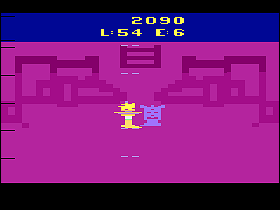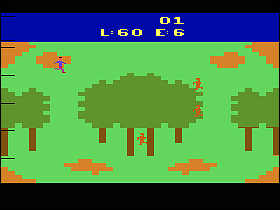 The Game: It’s not a good idea being a human on Earth of the future, in a world ruled ruthlessly by intelligent, verbose, violent apes. Or, in this case, persistent, pixellated apes. The player controls a hunted human trying to stay out of the apes’ damn dirty paws. If the human falls into the apes’ hands, an indelicate lobotomy is probably the best treatment he can expect. (20th Century Fox, 1983)
The Game: It’s not a good idea being a human on Earth of the future, in a world ruled ruthlessly by intelligent, verbose, violent apes. Or, in this case, persistent, pixellated apes. The player controls a hunted human trying to stay out of the apes’ damn dirty paws. If the human falls into the apes’ hands, an indelicate lobotomy is probably the best treatment he can expect. (20th Century Fox, 1983)
Memories: This is the story of a prototype that was rumored for many years, and with the popularity of the film and TV franchise, it was the subject of much speculation. Little did ardent collectors of unreleased VCS games know that the game was right under their noses the whole time… thanks to being mislabeled.
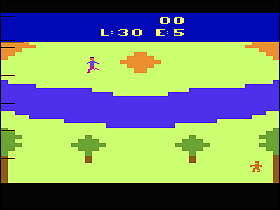 The Planet Of The Apes game was listed as an upcoming title by 20th Century Fox’s in-house video game division, but never hit the market. The prototype was found in the 1990s, but the cartridge casing was mislabeled Alligator People, another unreleased 20th title. After the inevitable ROM dump, Atari afficionados everywhere tried to figure out what the game was about.
The Planet Of The Apes game was listed as an upcoming title by 20th Century Fox’s in-house video game division, but never hit the market. The prototype was found in the 1990s, but the cartridge casing was mislabeled Alligator People, another unreleased 20th title. After the inevitable ROM dump, Atari afficionados everywhere tried to figure out what the game was about.
Silly apes. A later find of the actual Alligator People prototype made the answer instantly obvious: the game everybody thought was Alligator People made a hell of a lot more sense as Planet Of The Apes, especially in light of the pivotal scenes in the first movie where Charlton Heston’s character, Taylor, is on the run from those dirty apes. In the game, the 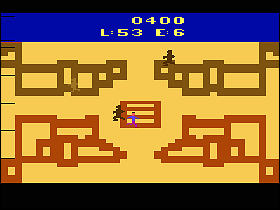 player is trying to keep his on-screen character out of the hands of the apes.
player is trying to keep his on-screen character out of the hands of the apes.
It’s a decent enough premise for a game, and not a bad license to build it on, though there’s a question of how relevant anything related to Planet Of The Apes – a franchise that’s generally perceived as having slowly fizzled rather than going out on a high note – would’ve been to generation Atari, which was probably too young to have experienced anything but reruns. By the time the Apes movies were in television repeats, the world had gone ape over another movie released by 20th Century Fox – Star Wars.
But the game does a good job of capturing the flavor of the first movie, from the maze-like ape village that must be escaped from if the player is caught, to fleeing by way of swimming down a river, to crossing desert wastelands and 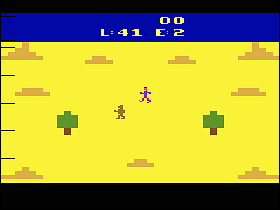 the catacombs of the forbidden zone until one reaches – finally – a glimpse of the buried and broken Statue of Liberty, accompanied by a Yars’ Revenge-ish burst of multicolored light. (Strangely enough, the game then returns to the beginning.)
the catacombs of the forbidden zone until one reaches – finally – a glimpse of the buried and broken Statue of Liberty, accompanied by a Yars’ Revenge-ish burst of multicolored light. (Strangely enough, the game then returns to the beginning.)
The game also takes into account that the movie franchise featured different types of apes, from harmless chimps to the warlike orangutangs. Chimps don’t hurt Taylor in the game, but orangutangs will shoot back at him. Taylor can shoot any or all of the apes he sees, but chimps – being harmless – net such a negligible score that it’s barely even worth bothering with them. (Orangutangs, on the other hand, are worth something like 200 points each.) Clearly the designer had some knowledge of the property he was basing a game on, and it shows some depth because of that.
The drawback? There’s something vaguely E.T.-ish about the structure of Planet Of The Apes. It’s a superior game to E.T., and not just because the player can shoot back 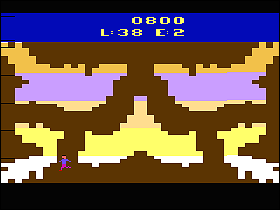 at those chasing him down, but it shares a number of similarities: the world-that’s-bigger-than-the-screen structure that never quite seems like it’s following a specific map, the ability to march out of one screen and instantly fall into mortal danger that you have no time to prepare for, and the reliance on a “life meter” rather than the traditional, arcade-inspired “lives.”
at those chasing him down, but it shares a number of similarities: the world-that’s-bigger-than-the-screen structure that never quite seems like it’s following a specific map, the ability to march out of one screen and instantly fall into mortal danger that you have no time to prepare for, and the reliance on a “life meter” rather than the traditional, arcade-inspired “lives.”
Had Planet Of The Apes been released in cartridge form, it’s likely that – in 1983 – it would’ve met with a somewhat indifferent audience, due to the age of the property and the nature of the game itself. It’s also possible that other twists and  additions might have been made before hitting the stores, refining the game play experience. But in 1983, the home video game industry was going the way of the extinct human society of the Apes movies, which may be the main reason 20th Century Fox kept the game hidden in the forbidden zone.
additions might have been made before hitting the stores, refining the game play experience. But in 1983, the home video game industry was going the way of the extinct human society of the Apes movies, which may be the main reason 20th Century Fox kept the game hidden in the forbidden zone.
